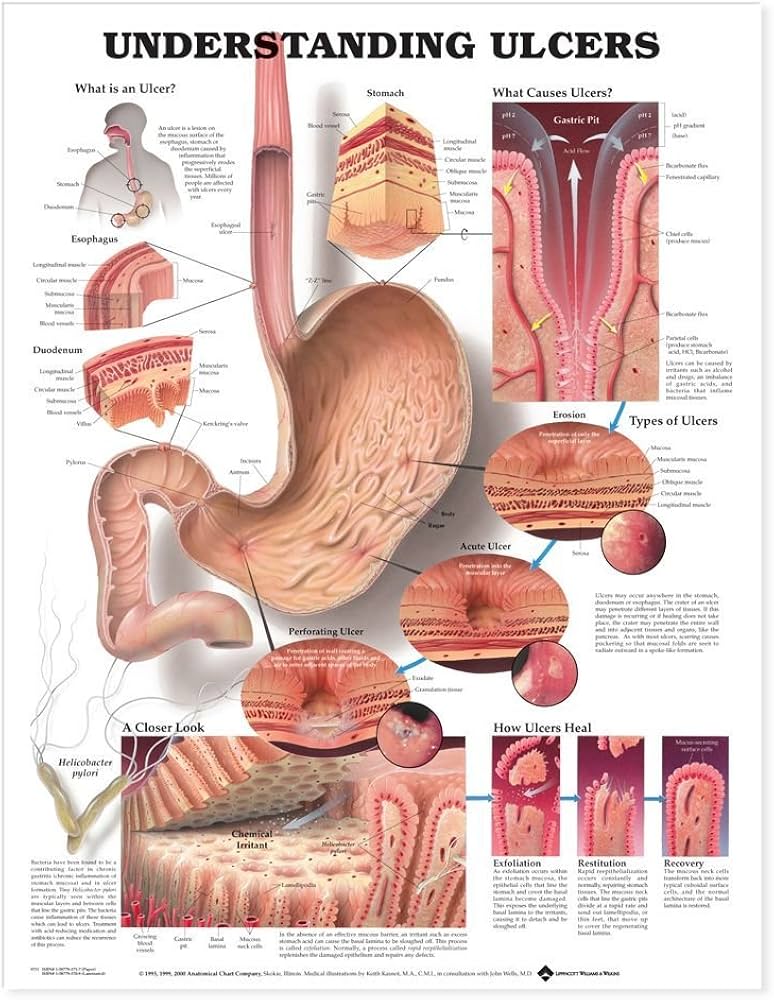
Ulcers are open sores that can develop on the skin or mucous membranes of the body. They are a common health issue, affecting millions of people worldwide. Understanding the types of ulcers, their causes, symptoms, and when to seek medical attention is crucial for effective management and treatment.
Definition of Ulcers
An ulcer is a break in the skin or mucous membrane that fails to heal properly. It can vary in size and can be painful, leading to various complications if left untreated. Ulcers can occur in different parts of the body, each with its own specific characteristics.
Types of Ulcers
1. Peptic Ulcers
Peptic ulcers are sores that develop on the lining of the stomach, small intestine, or esophagus. They can be classified into:
- Gastric Ulcers: Located in the stomach.
- Duodenal Ulcers: Found in the first part of the small intestine (duodenum).
Symptoms of Peptic Ulcers:
- Burning stomach pain
- Nausea or vomiting
- Bloating and indigestion
- Loss of appetite and weight loss
2. Mouth Ulcers
Mouth ulcers, also known as canker sores, are painful lesions that develop inside the mouth, on the gums, tongue, or inner cheeks. They can be quite uncomfortable and may hinder eating and speaking.
Symptoms of Mouth Ulcers:
- Painful, shallow sores
- Red or white lesions
- Sensitivity when eating or drinking
- Swelling around the ulcer
3. Skin Ulcers
Skin ulcers are open sores that can form on any part of the body, commonly on the legs, feet, or pressure points. They can result from various underlying conditions, including poor circulation, diabetes, or prolonged pressure on the skin.
Symptoms of Skin Ulcers:
- Redness or swelling around the sore
- Drainage or pus from the ulcer
- Pain or tenderness in the area
- Surrounding skin may appear darker or discolored
Common Causes of Ulcers
Ulcers can result from various factors, including:
1. Helicobacter pylori Infection
H. pylori is a type of bacteria that infects the stomach lining, often leading to peptic ulcers. The infection is common and can be treated effectively with antibiotics.
2. Stress
While stress is not a direct cause of ulcers, it can exacerbate existing conditions or lead to unhealthy coping mechanisms, such as poor diet or increased alcohol consumption, which may contribute to ulcer formation.
3. Medications
Certain medications, especially nonsteroidal anti-inflammatory drugs (NSAIDs) like ibuprofen and aspirin, can irritate the stomach lining and increase the risk of developing peptic ulcers.
Key Symptoms for Each Type
- Peptic Ulcers: Burning pain in the stomach, nausea, bloating, and changes in appetite.
- Mouth Ulcers: Painful sores, difficulty eating or talking, and swelling.
- Skin Ulcers: Open sores, swelling, drainage, and localized pain.
When to See a Doctor
It is essential to seek medical attention if you experience any of the following:
- Persistent abdominal pain or discomfort
- Vomiting blood or material that looks like coffee grounds
- Dark, tarry stools
- Symptoms that worsen or do not improve with over-the-counter treatments
- Mouth ulcers that last more than two weeks or are unusually large
Conclusion
Understanding ulcers— their types, causes, and symptoms— can help you identify and manage this common health issue effectively. If you suspect you have an ulcer or experience any concerning symptoms, do not hesitate to consult a healthcare professional for appropriate diagnosis and treatment. Early intervention is key to preventing complications and ensuring a swift recovery.

